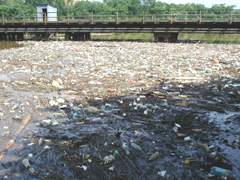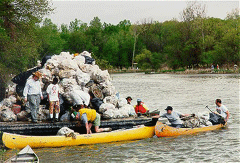Clean Water Anniversary
Air Date: Week of October 19, 2007

The Anacostia River drains 176 square miles of D.C. and Maryland. 70 percent of the wetlands have been lost over the last 250 years.
The Clean Water Act turns 35 years old this month. American rivers, lakes, and wetlands are a lot healthier than they were before the law’s inception. But the act’s goal of “fishable, swimmable” waterways has still not been realized. Jeff Young reports on the success and shortcomings of the Clean Water Act.
Transcript
CURWOOD: From the Jennifer and Ted Stanley Studios in Somerville, Massachusetts, this is Living on Earth. I’m Steve Curwood.
Until the early 1970s many of the nation’s rivers were virtually open sewers. Near Cleveland, the Cuyahoga River was so polluted it repeatedly caught fire. Today, lakes and rivers are much cleaner—thanks to the Clean Water Act. But some 40 percent of the country’s waterways still do not meet clean water standards. As the Clean Water Act turns 35 years old this month, Living on Earth’s Jeff Young reports it’s starting to look a little gray.
[SOUND OF WATER LAPPING]
YOUNG: James Lindsey watches his fishing line from the banks of the Anacostia River. The 53-year-old grew up here in Washington’s southeast and remembers when he wouldn’t come this close to the river.
LINDSEY: Used to be pretty dirty. You know, you could smell the filth, back in the day. You know and it could be better, it could be better. But it’s improved a whole lot, a whole lot.
YOUNG: It might be better now but Lindsey still should not eat the fish he catches. And swimming? That’s not safe, either, especially after a heavy rain. Part of the problem is just steps away, where a thin man in khakis and glasses pokes around a large pipe.
LEHNER: This is a combined sewer overflow discharge point. It is where on rainy days, unfortunately, raw sewage will be discharged into the Anacostia River.

A carpet of trash on the Anacostia River, Southeast, DC. (Courtesy of Anacostia Watershed Society)
LEHNER: Frankly, the runoff is the major failure of the Clean Water Act. It’s the major reason why still thousands of miles of waters are still not as clean as they should be.
YOUNG: From the little Anacostia to the mighty Mississippi, runoff –or nonpoint-source pollution—is the big threat. A new report from the National Academy of Sciences says the federal government should more aggressively use the Clean Water Act to combat nutrient pollution from fertilizer used on farms and fields. Purdue University agricultural economics professor Otto Doering helped write that study. Doering says the Act has done a good job on industrial discharges, called point sources.

Anacostia River cleanup, Earth Day 25 - April 1995(Courtesy of EPA)
YOUNG: The Academy report says there aren’t water quality standards for many stretches of the Mississippi and even monitoring data is lacking or not well coordinated. Doering says the Clean Water Act has not yet been fully applied to the problem of nutrient runoff. The result is a dead zone where marine life can’t live in low-oxygen waters where the river hits the Gulf of Mexico.
DOERING: The act was designed for those things that the public perceived as the 800-pound gorilla. We’ve done fairly well with that 800-pound gorilla. Now we’ve got another 800-pound gorilla.
YOUNG: The Clean Water Act also has problems upstream. Recent Supreme Court decisions limit the act’s authority over small streams and wetlands. And then, there’s the flow of money—or, rather, the lack of it. Federal funding for Clean Water projects like water lines and sewage treatment has dropped some 60 percent since the early 1990s, even as aging infrastructure is starting to break down. Oregon Democratic congressman Earl Blumenauer wants a long-term source of steady funding.
BLUMENAUER: If we’re able to establish a trust fund that is $10 billion, does that solve a long-term problem that is considered—by any estimate—is over half a trillion dollars? No. But it is significantly more than what we are doing now.

The Anacostia River drains 176 square miles of D.C. and Maryland. 70 percent of the wetlands have been lost over the last 250 years.(Courtesy of EPA)
YOUNG: Blumenauer says there’s broad public support for programs to help farmers reduce agricultural runoff and to help cities like Washington help keep the runoff from streets from causing sewage spills.
[SOUND OF WATER LAPPING]
YOUNG: Back on the banks of the Anacostia, Peter Lehner wonders when that support
will start to trickle down.
LEHNER: One would think that the capital lawmakers would care more about the river that goes through their backyard, but they seem not to. It might not catch fire like the Cuyahoga River did in 1972. But it’s certainly not swimmable, yet, even though the Clean Water Act’s goal is to have everything swimmable. It’s sad; they haven’t been willing to invest in our public infrastructure.
YOUNG: After 35 years with the Clean Water Act, all our rivers might not be fishable or swimmable, but at least they’re no longer flammable.
[MUSIC: Randy Newman “Burn On” from ‘Sail Away’ (Rhino—2002)]
YOUNG: For Living on Earth, I’m Jeff Young in Washington.
[MUSIC: Randy Newman “Burn On” from ‘Sail Away’ (Rhino—2002)]
Links
EPA on the Clean Water Act, its history and implementation
Food and Water Watch report on funding the Clean Water Act
Living on Earth wants to hear from you!
Living on Earth
62 Calef Highway, Suite 212
Lee, NH 03861
Telephone: 617-287-4121
E-mail: comments@loe.org
Newsletter [Click here]
Donate to Living on Earth!
Living on Earth is an independent media program and relies entirely on contributions from listeners and institutions supporting public service. Please donate now to preserve an independent environmental voice.
NewsletterLiving on Earth offers a weekly delivery of the show's rundown to your mailbox. Sign up for our newsletter today!
 Sailors For The Sea: Be the change you want to sea.
Sailors For The Sea: Be the change you want to sea.
 The Grantham Foundation for the Protection of the Environment: Committed to protecting and improving the health of the global environment.
The Grantham Foundation for the Protection of the Environment: Committed to protecting and improving the health of the global environment.
 Contribute to Living on Earth and receive, as our gift to you, an archival print of one of Mark Seth Lender's extraordinary wildlife photographs. Follow the link to see Mark's current collection of photographs.
Contribute to Living on Earth and receive, as our gift to you, an archival print of one of Mark Seth Lender's extraordinary wildlife photographs. Follow the link to see Mark's current collection of photographs.
 Buy a signed copy of Mark Seth Lender's book Smeagull the Seagull & support Living on Earth
Buy a signed copy of Mark Seth Lender's book Smeagull the Seagull & support Living on Earth

